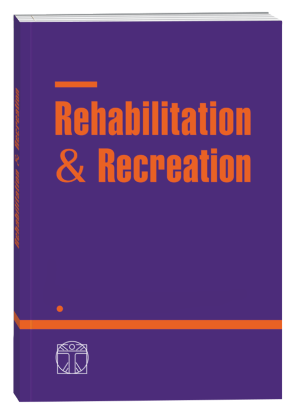ANALYSIS OF APPROACHES TO IDENTIFYING ACUTE, CHRONIC AND NON-SPECIFIC BACK PAIN OF ATHLETES
DOI:
https://doi.org/10.32782/2522-1795.2023.16.3Keywords:
nonspecific back pain, athletes, acute pain, chronic pain.Abstract
Non-specific back pain is one of the important problems of today, it affects almost all types of activities, this problem is one of the leading when people can end their sports career or stop doing their professional activities for a while to solve it. Athletes who have been doing their job for more than 10–15 years, suffering from this condition, depending on their age, can continue to compete in competitions thanks to their physical training. Another problem arises when it appears in an athlete who has just begun to master his sport trainings, at a young age, of course, you can ignore it and not pay attention to it, but it is still better to devote time to this issue, in order to prevent complications in the future and refusal to engage to take apart in sport that was chosen. Athlete results decreases quite significantly, but in most cases they try to adapt to this pain in order to continue doing their favorite job, so the analysis of how to better detect non-specific pain is considered one of the many important questions that need to be paid attention, to help such athletes solve their problem. Purpose is to analyze the condition of people with manifestations of non-specific back pain with the help of modern scientific research. Methods. Analysis and generalization of foreign data of special scientific and methodical literature, synthesis and generalization, survey. The results. The analysis of scientific works showed, that there are many studies that describe the physical and functional indicators of people suffering from various manifestations of non-specific, acute and chronic back pain. It was also found, that there are many factors of what exactly causes or may cause pain in the future. In addition to all this, pain can be both, a mental manifestation and a reaction to the athlete’s fatigue, and accompany the occurrence of some disease, which indicates a possible further deterioration of the person’s condition in the future, change of place of employment, and in the worst possible case, to lethal ending.
References
Mo, A.Z. & Gjolaj, J.P. (2021). Axial Low Back Pain in Elite Athletes. Clin Sports Med. Vol. 40(3). Pp. 491–499. PMID: 34051942. doi: 10.1016/j.csm.2021.03.005.
Jonge de, M.C. & Kramer, J. (2014). Spine and sport. Semin Musculoskelet Radiol. Vol. 18(3). Pp. 246–264. Epub Jun 4 2014. PMID: 24896742. doi: 10.1055/s-0034-1375568
Gobbo, S., Bullo, V., Bergamo, M., Duregon, F., Vendramin, B., Battista, F., Roma, E., Bocalini, D.S., Rica, R.L., Alberton, C.L., Cruz- Diaz, D., Priolo, G., Pancheri, V., Maso, S., Neunhaeuserer, D., Ermolao, A. & Bergamin, M. (2019). Physical Exercise Is Confirmed to Reduce Low Back Pain Symptoms in Office Workers: A Systematic Review of the Evidence to Improve Best Practices in the Workplace. J Funct Morphol Kinesiol. Vol. 4(3). Pp. 43. PMID: 33467358; PMCID: PMC7739349. doi: 10.3390/ jfmk4030043
Chenot, J.F., Greitemann, B., Kladny, B., Petzke, F., Pfingsten, M., & Schorr, S.G. (2017). Non-Specific Low Back Pain. Dtsch Arztebl Int. No. 114(51–52). Pp. 883–890. PMID: 29321099; PMCID: PMC5769319. doi: 10.3238/ arztebl.2017.0883
Otero-Ketterer, E., Peñacoba-Puente, C., Ferreira Pinheiro-Araujo, C., Valera-Calero, J.A. & Ortega-Santiago, R. (2022). Biopsychosocial Factors for Chronicity in Individuals with Non-Specific Low Back Pain: An Umbrella Review. Int J Environ Res Public Health. Vol. 19(16). Pp. 10145. PMID: 36011780; PMCID: PMC9408093. doi: 10.3390/ijerph191610145
Hayden, J.A., Wilson, M.N., Riley, R.D., Iles, R., Pincus, T. & Ogilvie, R. (2019). Individual recovery expectations and prognosis of outcomes in non-specific low back pain: prognostic factor review. Cochrane Database Syst Rev. No. 11. Pp. 11284. PMID: 31765487; PMCID: PMC6877336. doi: 10.1002/14651858. CD011284.pub2
Bernal-Utrera, C., Gonzalez-Gerez, J.J., Anarte-Lazo, E. & Rodriguez-Blanco, C. (2020). Manual therapy versus therapeutic exercise in non-specific chronic neck pain: a randomized controlled trial. Trials. Vol. 21(1). Pp. 682. PMID: 32723399; PMCID: PMC7385865. doi: 10.1186/s13063-020-04610-w
Wand, B.M., & O’Connell, N.E. (2008). Chronic non-specific low back pain – sub-groups or a single mechanism? BMC Musculoskelet Disord. No. 9. Pp. 11. PMID: 18221521; PMCID: PMC2266926. doi: 10.1186/1471-2474-9-11
Szulc, P., Wendt, M., Waszak, M., Tomczak, M., Cieślik, K. & Trzaska, T. (2015). Impact of McKenzie Method Therapy Enriched by Muscular Energy Techniques on Subjective and Objective Parameters Related to Spine Function in Patients with Chronic Low Back Pain. Med Sci Monit. Vol. 21. Pp. 2918–2932. PMID: 26418868; PMCID: PMC4596425. doi: 10.12659/MSM.894261
O’Keeffe, M., O’Sullivan, P., Purtill, H., Bargary, N. & O’Sullivan, K. (2020). Cognitive functional therapy compared with a groupbased exercise and education intervention for chronic low back pain: a multicentre randomised controlled trial (RCT). Br J Sports Med. Vol. 54(13). Pp. 782–789. Epub Oct 19 2019. PMID: 31630089; PMCID: PMC7361017. doi: 10.1136/ bjsports-2019-100780
Downloads
Published
How to Cite
Issue
Section
License

This work is licensed under a Creative Commons Attribution-NonCommercial-NoDerivatives 4.0 International License.












